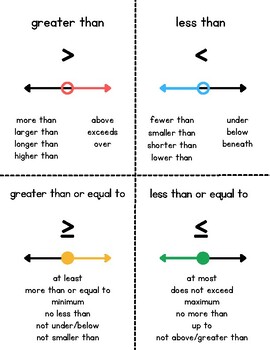Inequality Word Problem Key Words w/ GRAPHS Anchor Chart Word Map
- PDF
What educators are saying
Also included in
- Word problems can be tough! Many of my students struggle with breaking apart word problems with both basic operations as well as inequalities. With this, I made anchor charts that identify key words that are commonly seen in word problems. 1: Basic Operations-- Addition + | Subtraction - | MultiplicPrice $10.00Original Price $13.00Save $3.00
Description
Greater Than > | Less Than < | Greater Than or Equal To ≥ | Less Than or Equal To ≤ | Number Line Graphing
Sometimes it can be tricky to figure out exactly what a word problem is asking you to do. With this word map, students will be able to connect the words they are seeing in their math problem to the mathematical operation and corresponding graph.
I created this tool in order to support my students who were getting caught up in the language of word problems. Being able to solve word problems helps students practice real-world problem solving, so providing students with key words can motivate them to be independent.
There are three versions of this chart included in the purchase:
1: color
2: no color
Please leave a review and I would love to see pictures of how this is being used with your students!




